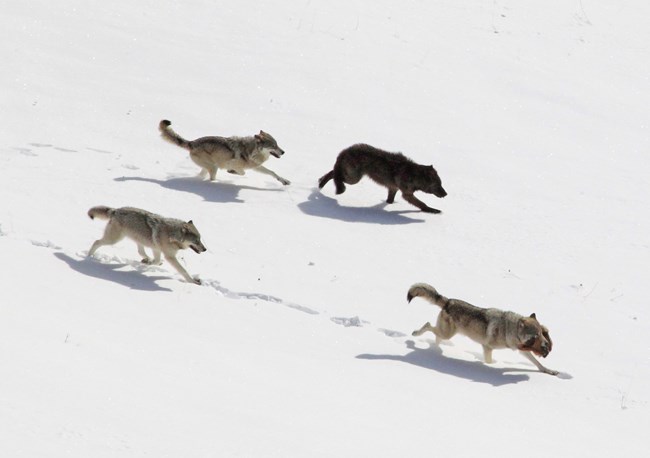
From Yellowstone Science 23(2): 2015, pages 96-97.
Douglas W. Smith
Like grizzly bears, wolves lived across huge swaths of North America, as well as Europe, Asia, and the Middle East, making them one the most widely distributed mammals. In a matter of a few centuries, humans reduced the majority of this extensive world-wide range and population. An obligate carnivore, humans initially respected the wolf as a hunter, sometimes patterning our ways after them, and occasionally respecting them with religious awe. For some cultures this is still the case. About the time of the agricultural revolution 10,000 years ago, things changed. With the domestication of some wildlife into livestock, their natural defenses against predators were bred out of them to ease coexistence with humans—animal husbandry—and wolves took advantage of it. Livestock was easy prey, and the truce between wolves and humans ended. Wolves were killed. The killing was limited until the advent of steel for making traps and recipes for poisoning took hold in the mid-1800s. With this technology wolves were wiped out from large areas across Asia and virtually all of Europe and the continental United States, except for a thin sliver of northern Minnesota. The only thing that protected them was remoteness. As Teddy Roosevelt, an early Yellowstone advocate, said, "They were the beast of waste and desolation." Early park policy in Yellowstone was to kill them, and superintendents regularly reported on the annual kill count. The last wolf was killed in the park in 1926. This enthusiasm to exterminate has rarely been equaled. Wolves were thought to directly oppose civilization and the manifest destiny mindset of the time. They were killed with near religious fervor—sometimes tortured or captured and released without a lower jaw. It is a wonder there is any place they survived.Once the airplane came along, it too was used to penetrate any protection remoteness offered. The 1950s probably saw the low ebb of wolf numbers world-wide. Around this time some of the zeal to kill abated, and too, imperceptibly, human attitudes softened. Some bounties survived into the 1960s, but wolves had been eliminated from most populated areas by this time so it escaped our attention. With a break from the elimination pressure, wolves crept back. First quietly populating the remote regions, and with poison mostly banned, they had a chance. Some people even spoke out in their favor, but this was not more than a very few until the 1960s. Around this time the vast depopulation of a species was acknowledged, and some wondered about its impacts. Virtually nothing was known about this animal, and it was gone before we knew what it did. Some early visionaries, in both the U.S. and Canada, pondered this and initiated studies in the late 1950s. Set in parks, there was an appreciation that predators may have served a purpose. Concerns also began to surface about burgeoning numbers of ungulates and their impact on the environment. Adolph Murie, a researcher in Yellowstone and Denali national parks, documented Isle Royale National Park without wolves—too many moose and the forest declined. This was dire enough that park officials attempted a reintroduction in 1952.This effort failed, but unbeknownst to park officials wolves came back themselves across Lake Superior ice in the late 1940s. Durward Allen saw the opportunity and started a study in 1958 that runs to this day—the longest of its kind. Much of the work is landmark due to its length and has led to difficult-to-acquire insights about how nature works with wolves. A sister study in another park in Ontario, Canada, began in 1959 with Douglas Pimlott. It too has run almost continuously to this day. Together these studies improved our understanding of wolves and spawned other studies—many other studies. But with stacks of studies, the struggle remained on how to live with them. Knowledge led to some understanding and appreciation, but not in the hearts and minds of many. Some still felt wolves should be relegated to the unpeopled lands. It is with this backdrop that Yellowstone steps in during the mid-1990s even though Yellowstone is not unpeopled. We sit in the middle of the lower-48 with millions of people coming to the park each year. With rare public profile, wolves returning to the world's first national park got a lot of attention. The questions "What good are they?" and "Should we do this?" became more significant than ever. Yellowstone was a ground zero. Powered by the Endangered Species Act (ESA) and National Park Service policy, but also because many people supported it, reintroduction was approved to move forward. The question remained "How do we do this?" –natural immigration like what happened near Glacier National Park or reintroduction? Yellowstone is more isolated than Glacier. Although large with the surrounding public land, it's essentially not ecologically connected to anything. Some feared the overt action of reintroduction sponsored by the federal government would be equated to "cramming wolves down our throat." They were right. But the reintroduction in Yellowstone was able to relax some of the stringent regulations of the ESA, like livestock protection, which was a key provision. So wolf reintroduction won out and played out with the world watching.In the winter of 1995, with much fanfare, 14 wolves were reintroduced to Yellowstone and 20 to central Idaho from a source population in Canada. What happens next stops here and begins in the next issue of Yellowstone Science! |
Last updated: December 21, 2015
